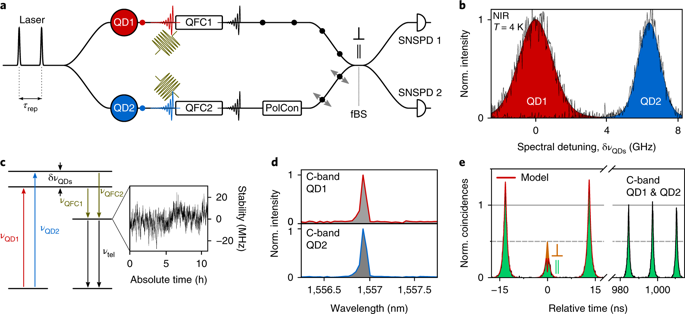Nature Nanotechnology ( IF 38.3 ) Pub Date : 2018-10-22 , DOI: 10.1038/s41565-018-0279-8 Jonas H. Weber , Benjamin Kambs , Jan Kettler , Simon Kern , Julian Maisch , Hüseyin Vural , Michael Jetter , Simone L. Portalupi , Christoph Becher , Peter Michler

|
Efficient fibre-based long-distance quantum communication via quantum repeaters relies on deterministic single-photon sources at telecom wavelengths, potentially exploiting the existing world-wide infrastructures. For upscaling the experimental complexity in quantum networking, two-photon interference (TPI) of remote non-classical emitters in the low-loss telecom bands is of utmost importance. Several experiments have been conducted regarding TPI of distinct emitters, for example, using trapped atoms1, ions2, nitrogen vacancy centres3,4, silicon vacancy centres5, organic molecules6 and semiconductor quantum dots7,8. However, the spectral range was far from the highly desirable telecom C-band. Here, we exploit quantum frequency conversion to realize TPI at 1,550 nm with single photons stemming from two remote quantum dots. We thereby prove quantum frequency conversion9,10,11 as a bridging technology and a precise and stable mechanism to erase the frequency difference between independent emitters. On resonance, a TPI visibility of 29 ± 3% has been observed, limited only by the spectral diffusion processes of the individual quantum dots12,13. The local fibre network used covers several rooms between two floors of the building. Even the addition of up to 2 km of fibre channel shows no influence on the TPI visibility, proving the photon wavepacket distortion to be negligible. Our studies pave the way to establish long-distance entanglement distribution between remote solid-state emitters including interfaces with various quantum hybrid systems14,15,16.
中文翻译:

远程量子发射器对光子进行频率转换后,电信C波段中的双光子干扰
通过量子转发器进行的基于光纤的高效长距离量子通信依赖于电信波长的确定性单光子源,有可能利用现有的全球基础设施。为了提高量子网络中的实验复杂性,低损耗电信频段中的远程非经典发射器的两光子干扰(TPI)至关重要。已经针对不同发射体的TPI进行了一些实验,例如,使用捕获的原子1,离子2,氮空位中心3,4,硅空位中心5,有机分子6和半导体量子点7,8。但是,频谱范围远没有达到人们所期望的电信C波段。在这里,我们利用量子频率转换来实现在1,550 nm处的TPI,并且具有来自两个远程量子点的单个光子。因此,我们证明了量子频率转换9,10,11作为一种桥接技术以及一种精确稳定的机制,可以消除独立发射器之间的频率差。在共振时,已观察到TPI可见度为29±3%,仅受单个量子点的光谱扩散过程的限制12,13。所使用的本地光纤网络覆盖了建筑物两层之间的多个房间。即使增加长达2 km的光纤通道,也不会影响TPI可见度,从而证明光子波包失真可以忽略不计。我们的研究为在远程固态发射器之间建立长距离纠缠分布铺平了道路,其中包括与各种量子混合系统14,15,16的接口。



























 京公网安备 11010802027423号
京公网安备 11010802027423号